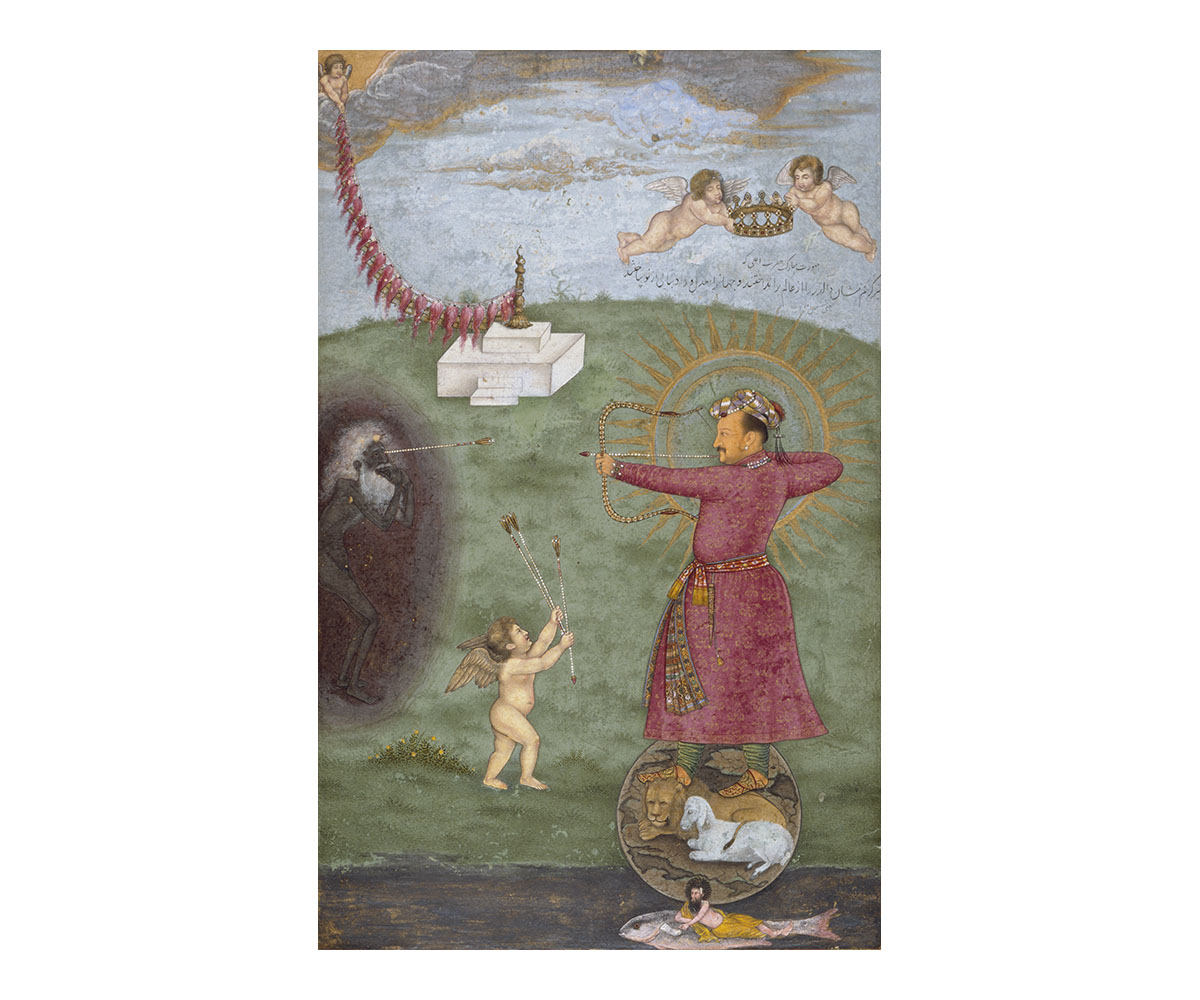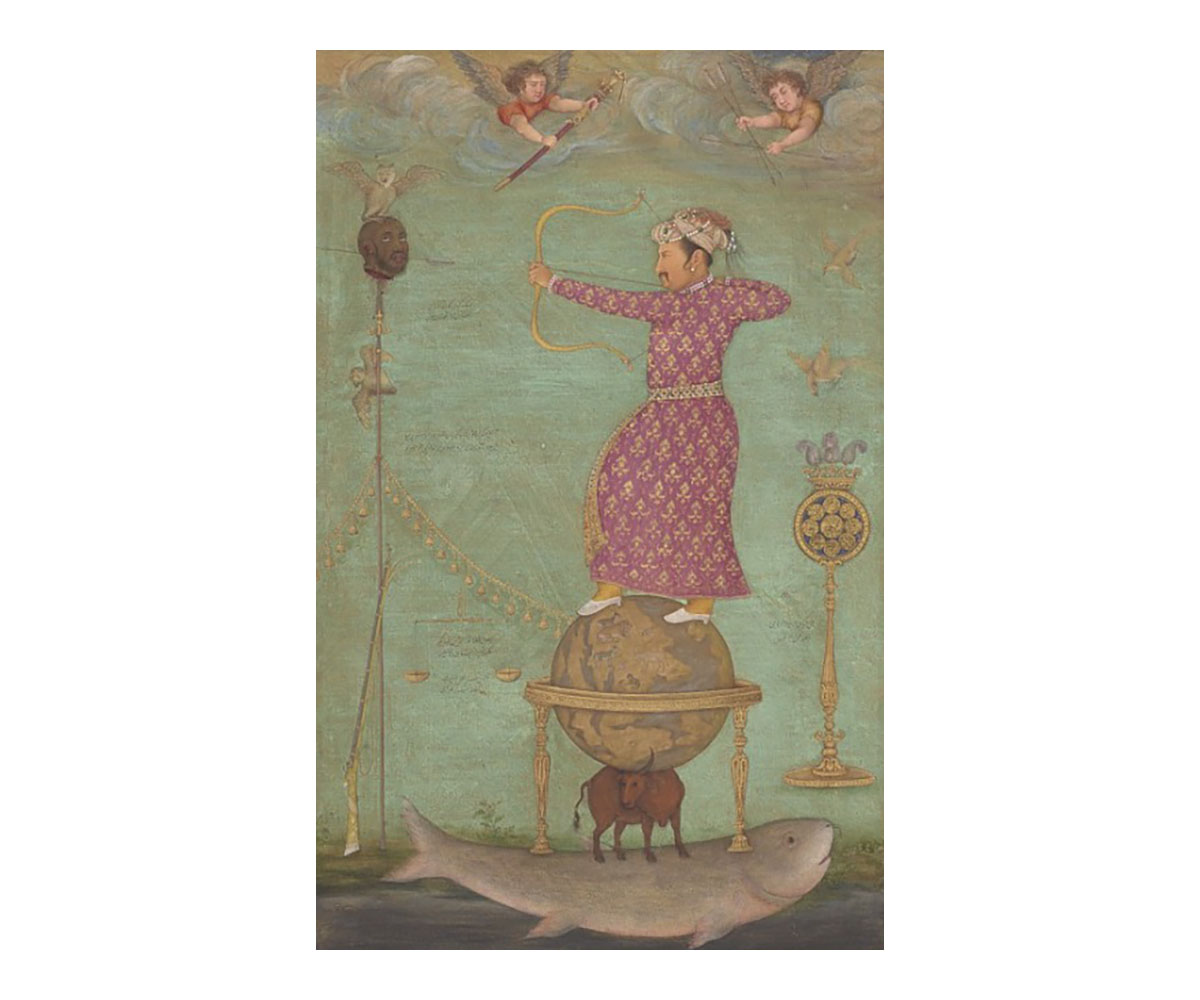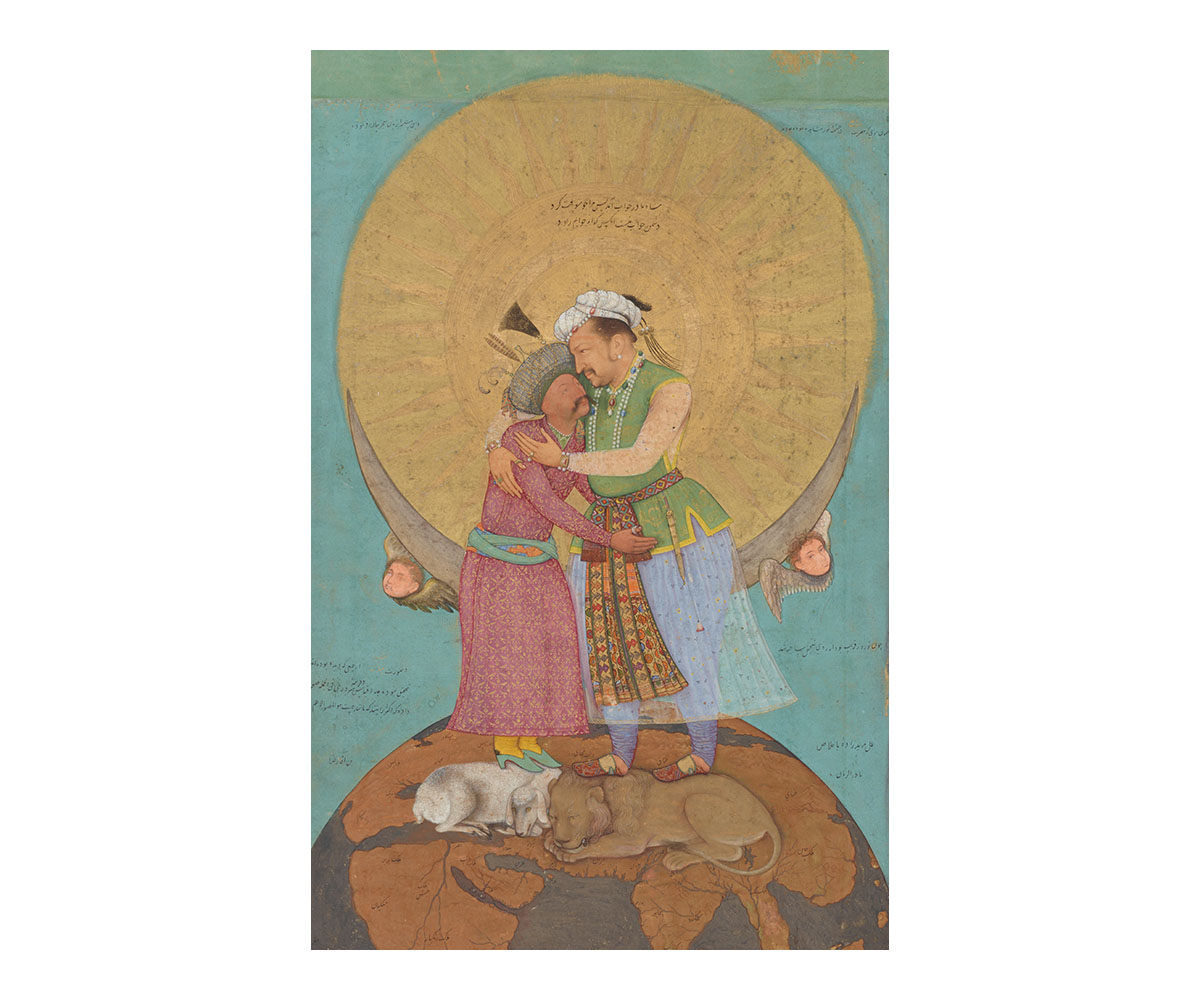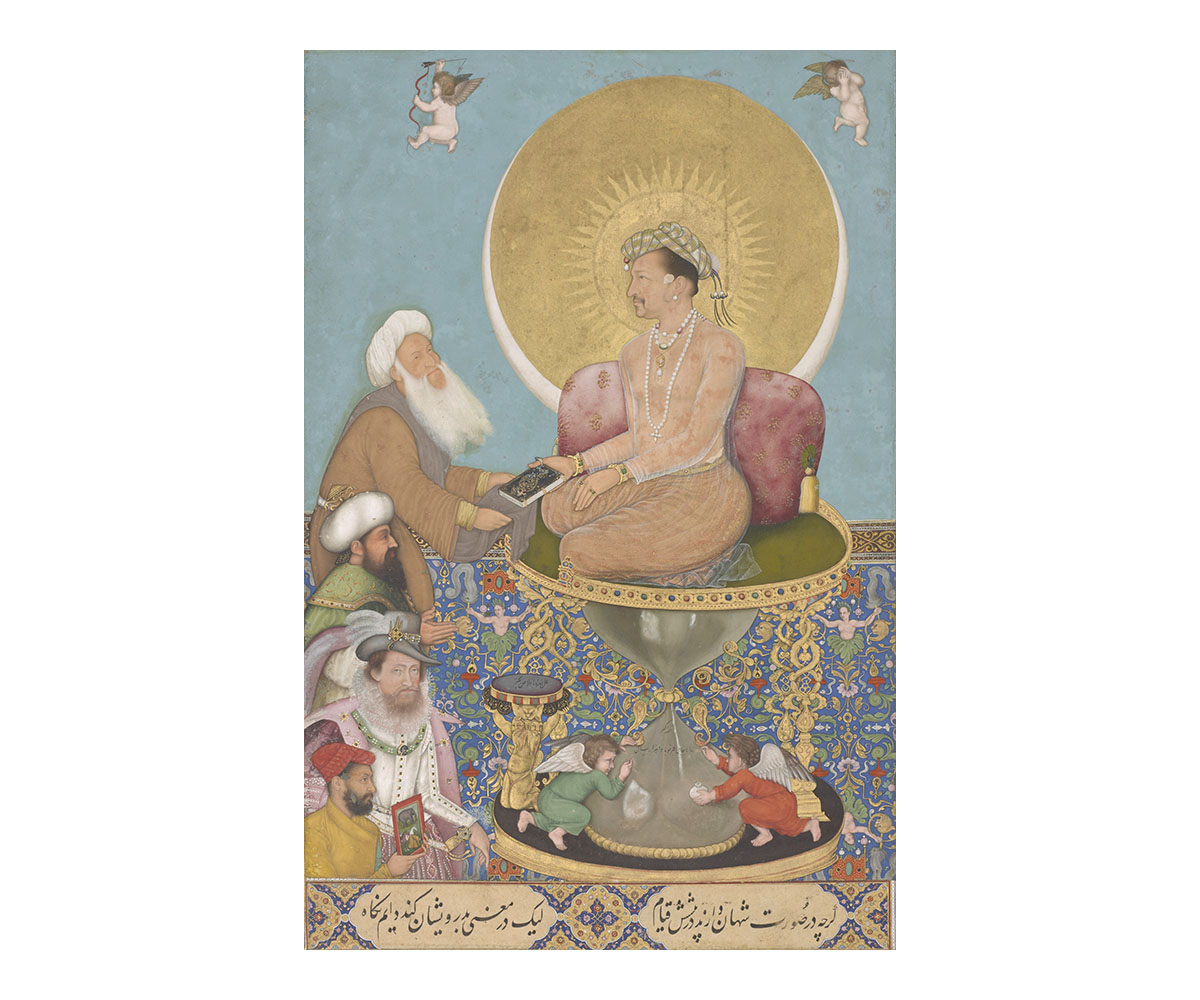PERSPECTIVES
European Cherubs and Hindu Gods: A Portrait of Emperor Jahangir
The Mughal emperor Jahangir, dressed in red robes and framed by a golden halo aims his bow and arrow at an emaciated, white-bearded man surrounded by a dark haze. The delicate golden embroidery on his garments, the glimpse of an emerald bracelet at his wrist and the strings of pearls and gems at his neck, along with his assertive stance and symbols of imperial power such as the crown held above his head and the sun-like golden nimbus surrounding him, lets viewers know that this is an imperial portrait. This is further reinforced by the inscription above Jahangir which says:
The auspicious portrait of his exalted majesty, who by the arrow of generosity eradicated the trace of Daliddar [the very personification of poverty] from the world and laid the foundation of a new world with his justice and munificence.
This painting, Emperor Jahangir Triumphing Over Poverty, painted by Abu’l Hasan (active 1600–1628) depicts the Emperor shooting an anthropomorphised figure representing poverty. Mughal imperial portraits such as this one are imbued with visual splendour and complex allegory and are among the most remarkable artefacts of early modern South Asia. They reveal to us the ambitions of the rulers they depict who often used them as a tool to present idealised versions of themselves. Let’s delve deeper to understand how this painting deploys visual motifs from Persianate, Indian and European traditions to construct Jahangir’s image as a saintly king who was a messiah to his subjects.
Jahangir as Conqueror of the Earth and Embodiment of the Sun
Note how Jahangir’s figure is framed by two orbs: the halo that encircles his head finds a parallel in the globe that he stands upon. When Prince Salim ascended to the throne, he adopted Jahangir — world-seizer — as his name and Nur ud-Din — light of the faith — as his title of honor. The central composition of the painting, with the motif of the halo and the globe, underscores this association to Jahangir’s imperial name.
Also appearing in other portraits such Jahangir Preferring a Sufi Shaikh to Kings by Bichitr, the halo alludes to the solar symbolism associated with Mughal kingship — the Mughal ruler was often regarded as the sun incarnate. In the Tuzuk-i-Jahangiri, Jahangir’s autobiography, he states “my sitting on the throne coincided with the rising and shining on the earth of the great light.” Abu’l-Fazl, Akbar’s court chronicler, says that: “[…] Kingship is a light emanating from God, a ray from the sun…It is communicated by God to kings without the intermediate assistance of anyone […]” The terrestrial globe came to the Mughal court via European ambassadors and visitors who arrived through mercantile networks. Jahangir quickly understood and exploited the potential of this symbol in his own portraits, in which the globe became an imperial prop, much like the halo and the crown, that represented Jahangir’s worldliness and his control over his territorial holdings. Multiple portraits of Jahangir, such as Jahangir Shooting the Head of Malik Ambar and Emperor Jahangir Embraces Shah Abbas depict him as standing or sitting with his feet on the globe — quite literally seizing the world and asserting his dominance over it.
Christian Influences: Haloes, Putti and Allusions to King Solomon
The cherubs that attend upon Jahangir in this work are inspired by the Polyglot Bible that was presented by Jesuit priests to Akbar, who had stayed at the Mughal court from 1580-1583 at the invitation of the emperor. The lion and sheep at Jahangir’s feet — also from the Polyglot Bible — associate the emperor with depictions of the biblical king Solomon, generally portrayed as having overcome the natural antagonism of animals through divine grace. Alluding to Solomon also reinforced Mughal rulers’ claim to messianic kingship. The metaphor of animals being pacified by Jahangir’s just rule was built upon the Polyglot Bible’s depiction of an ox, a lion, a lamb and a wolf seated together, symbolising the union of nations in the Christian faith. Co-opted by the Mughals, this image often adorned globes and was known in Persian as dad-o-daam — translating roughly to beast and prey and allegorically symbolising the power of the universal ruler to assert his dominion over the natural world, using his divine grace to allow hunter and hunted to coexist harmoniously. Jahangir’s radiant golden halo recalls European images of divine figures. The Mughals adopted Christian symbols, as scholar Ebba Koch states, “less out of religious motivation, as the Jesuits were disappointed to note, than in search of suitable ideas and symbols to broaden their image as universal rulers with another deifying dimension.”
Hindu Mythologies and the Reinforcement of Jahangir as a Saint-King
The Mughals were selective in their absorption of ideas and symbols from multiple sources — more akin to curation than wholesale adoption. The globe upon which the emperor stands may have originated from European cartography, but it is depicted, per Islamic conventions, as resting on other figures. However, while Islamic tradition would dictate that the globe be shouldered by an angel atop the cosmic bull, Kuyutha, who stands on a large fish, Bahamut, here we see a Hindu ascetic riding a fish instead. This is believed to be the lawgiver Manu, who was rescued from the primordial deluge by the god Vishnu in the form of a fish, known as the Matsya avatar, thus beginning a new cosmological cycle. While the painting depicts poverty being vanquished by Jahangir, it also actively describes the “foundation of a new world with justice and munificence.” By depicting the Matsya avatar, which denoted the beginning of a new epoch in Hindu mythology, this aspect of Jahangir’s rule is visually underscored.
At the centre of the painting, we see the heroic Jahangir slaying a cowering villain — suggesting a connection of the emperor to the Hindu god-king Rama (also an avatar of Vishnu) who inaugurated a new cosmological cycle by triumphing over evil. According to the scholar, Jasper van Putten, the symmetric composition with Jahangir and Daliddar, the embodiment of poverty, on opposite sides of the frame is very similar to the compositions of illustrations found in Persian copies of the Ramayana commissioned by Jahangir’s father, Akbar, in the 1580s. Another painting by Abu’l Hasan, Jahangir Shooting the Head of Malik Ambar, also makes use of the same martial stance. Much like the images of Rama and his brother Laxman vanquishing demons, here we see a dark, monstrous figure cowering before the haloed stately presence of Jahangir. The painting suggests that poverty and disorder had been vanquished by Jahangir, the saint-king who had restored the world as expected in contemporary Islamic belief.
Yet, in the 1620s, when this work was made, eyewitness records and administrative records suggest that most of the Mughal emperor’s subjects lived in poverty. The artist of this work, Abu’l Hasan, a protege of Jahangir’s, must also have known that his patron’s health and grip over his empire were deteriorating. As such, Emperor Jahangir Triumphing Over Poverty is possibly an attempt by the master painter to shore up the emperor’s public and personal image using symbols and themes familiar both to the cosmopolitan Mughal court and the populace at large, since such imperial portraits were often copied and sold in bazaars.
The developments we’ve examined — depictions of the emperor as an “ideal” man renewing and ruling over a diverse society and the use of visual allegories drawn from European, Hindu and Persian iconography — went on to become the most recognisable aspects of Mughal imperial portraits.
Bibliography
Abu al-Fazl and Henry Beveridge. The Akbarnāmā of Abu-l-Fazl. New Delhi: Low Price Publications, 2017.
Beach, Milo Cleveland. “The Mughal Painter Abu’l Hasan and Some English Sources for His Style.” Journal of the Walters Art Gallery 38 (1980): 6–33.
Jahangir. The Tūzuk-i-Jahāngīrī, or, Memoirs of Jahāngīr, edited by Henry Beveridge, translated by Alexander Rogers. New Delhi: Atlantic Publishers & Distributors, 2015.
Koch, Ebba. “Being Like Jesus and Mary: The Jesuits, the Polyglot Bible and Other Antwerp Print Works at the Mughal Court.” In Transcultural Imaginations of the Sacred, by Margit Kern and Klaus Krüger, 197–230. Berlin: William Fink Verlag, 2019.
———. “Jahangir as Publius Scipio Maior: The Commensurability of Mughal Political Portraiture”. In Portraiture in South Asia Since the Mughals: Art, Representation and History, edited by Crispin Branfoot, 73–90. London: Bloomsbury Publishing, 2019.
———.“The Influence of the Jesuit Missions on Symbolic Representations of the Mughal Emperors.” In Mughal Art and Imperial Ideology: Collected Essays, Ebba Koch, 1–11. Oxford: Oxford University Press, 2001.
———. “The Mughal Emperor as Solomon, Majnun, and Orpheus, or the Album as a Think Tank for Allegory.” Muqarnas 27 (2010): 277–311. http://www.jstor.org/stable/25769700.
Malecka, Anna. “Solar Symbolism of the Mughal Thrones. A Preliminary Note.” Arts Asiatiques 54, no. 1 (1999): 24–32. doi:10.3406/arasi.1999.1430.
Moin, A. Azfar. The Millennial Sovereign: Sacred Kingship and Sainthood in Islam. New York City: Columbia University Press, 2012.
Ramaswamy, Sumathi. “Conceit of the Globe in Mughal Visual Practice.” Comparative Studies in Society and History 49, no. 4 (2007): 751–82.
Putten, Jasper van. “Jahangir Heroically Killing Poverty.” The Meeting Place of British Middle East Studies: Emerging Scholars, edited by Amanda Phillips and Refqa Abu-Remaileh. Accessed May 7, 2024. https://www.academia.edu/1488148/Jahangir_Heroically_Killing_Poverty.
Skelton, Robert. “Imperial Symbolism in Mughal Painting.” In Content and Context of Visual Arts in the Islamic World, edited by Priscilla Soucek, Carol Bier and Richard Ettinghausen, 177–91. Pennsylvania: Pennsylvania State University Press, 1988.
Seyller, John. “Workshop and Patron in Mughal India: The Freer Rāmāyaṇa and Other Illustrated Manuscripts of ‘Abd Al-Raḥīm.” Artibus Asiae 42 (1999): 3–34.







